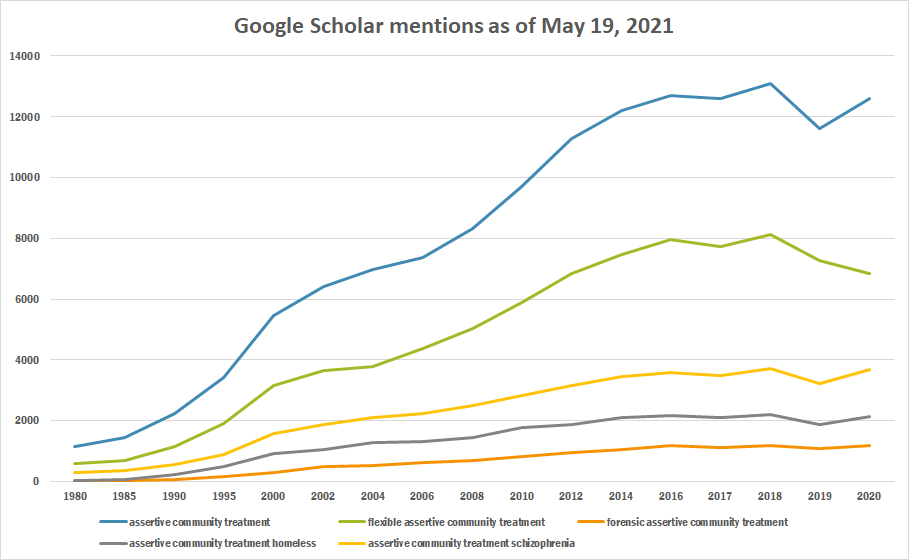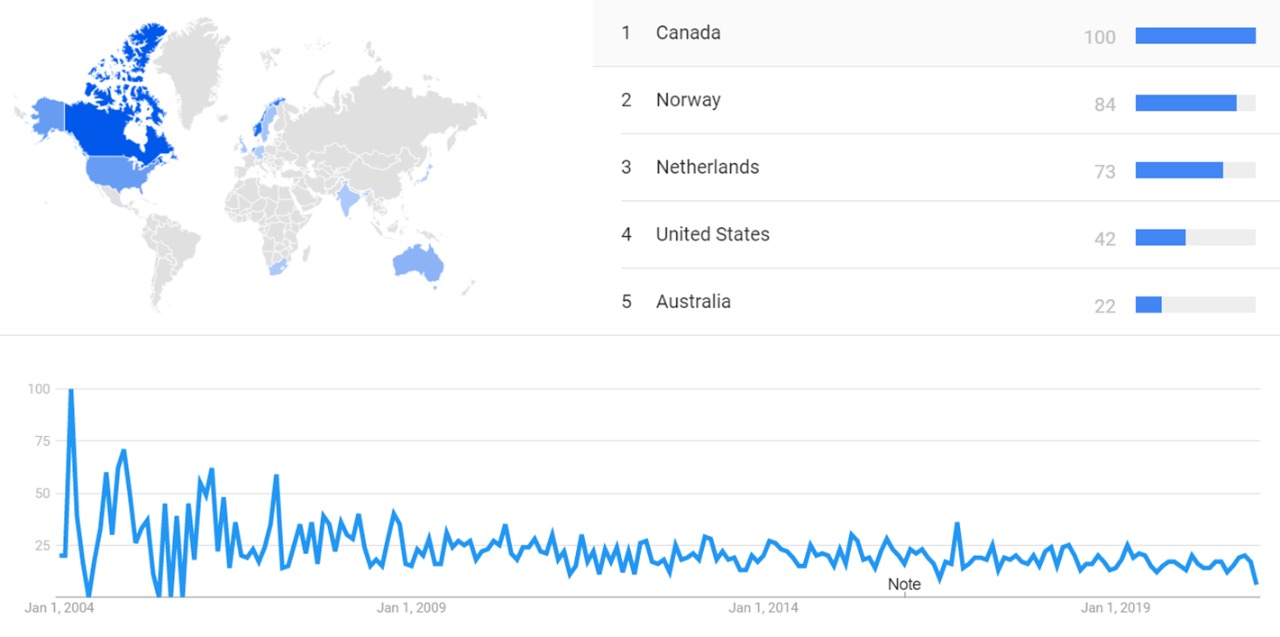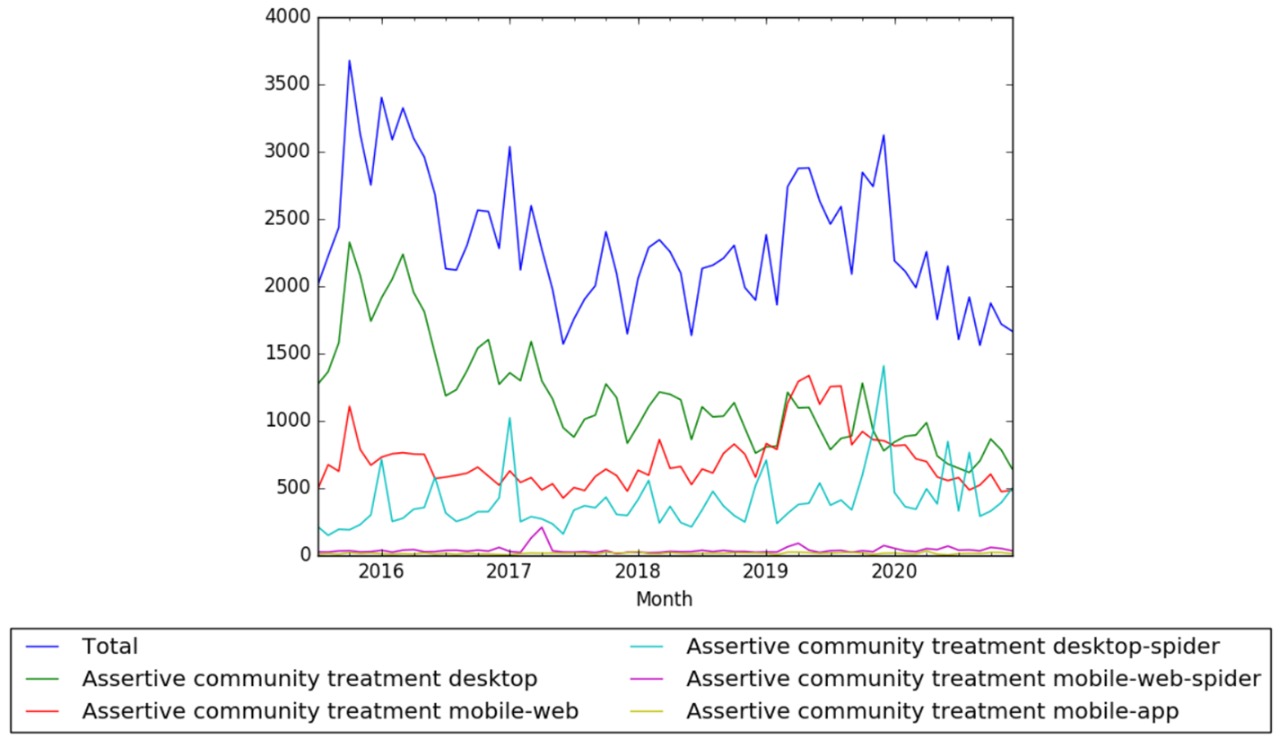Timeline of assertive community treatment
This is a timeline of assertive community treatment, a service-delivery model that provides comprehensive, locally based treatment to people with serious and persistent mental illnesses.[1] The program is considered one of the densest and most comprehensive models of care management to support community living for people with mental disorders.[2] ACT has been widely implemented in the United States, Canada, and England.[3]
Big picture
| Time period | Development summary |
|---|---|
| 1960s | ACT starts development late in the decade.[4] |
| 1970s | ACT is launched in the early 1970s in Madison, Wisconsin by a group of clinicians who believe that persons with severe mental illness should be given the opportunity to live in the community by receiving intensive treatment, rehabilitation, and support there, rather than on long-term mental hospital wards.[5]. The approach subsequently spreads throughout the United States, especially in the Midwest.[6] |
| 1980s | A tension between ACT as a possible model for all persons with mental illness and the need to focus ACT development on the most costly and difficult to treat populations remains in the decade.[7] |
| 1990s | Forensic assertive community treatment (FACT) develops as a variant of ACT.[8] |
| 2000s | Flexible Assertive Community Treatment (FACT) deveops as a Dutch variant of ACT.[9] |
Full timeline
| Year | Event type | Details | Location |
|---|---|---|---|
| Late 1960s | Development | Arnold Marx, Mary Ann Test, and Leonard Stein at Mendota State Hospital in Madison, Wisconsin start development of their Program Of Assertive Community Treatment.[4] | United States (Wisconsin) |
| 1972 | Development | Arnold Marx, Mary Ann Test, and Leonard Stein move hospital-ward treatment staff into the community to test their Program Of Assertive Community Treatment.[4][10] | United States (Wisconsin) |
| 1973 | Implementation | The Program of Assertive Community Treatment (PACT), also called "Madison Model", is formally launched. The program is designed to teach life skills to patients in the community, rather than in a state hospital.[11] | United States (Wisconsin) |
| 1974 | Achievement | The training in ACT receives the Gold Achievement Award from the Hospital and Community Psychiatry Service of the American Psychiatric Association.[12] | United States |
| 1978 | Implementation | The first big-city adaptation of ACT and the first such program to focus on the most frequently hospitalized segment of the mental health consumer population is developed in Chicago, and called Bridge assertive outreach program.[13] | United States, Illinois |
| 1978 | Research | Test and Stein, the inventors of ACT, report: “Community treatment results in less time spent in the hospital. This finding is certainly not surprising since experimental patients were usually not admitted to hospitals initially and there were subsequent concentrated efforts to keep them out.”.[14] | United States |
| 1980 | Development | In order to deinstitutionalize patients with severe mental illness, Stein describes in the United States the Assertive Community Treatment model (ACT), characterized as an individualized, intensive, multidisciplinary treatment.[15] | United States |
| 1987 | Implementation | The Connecticut Department of Mental Health begins creating assertive community treatment teams.[16] | United States (Connecticut) |
| 1988 | Implementation | California creates two integrated service agencies that combine ACT with a capitated model of funding. Unlike the full-fidelity model, these programs specifically target a cross-section of persons with severe mental illness rather than focusing exclusively on high service utilizers.[17] | United States (California) |
| 1990 | Implementation | An ACT program is established in the Delaware correctional system, designed to ease the transition of drug-involved prison releasees into the community by providing both treatment and case management services.[18] | United States (Delaware) |
| 1990 | Research | Harbinger determines that indirect service requirements inherent in the ACT team treatment model could reach over 50% of the cost of care, as service intensity approaches one contact per month.[7] | United States |
| Early 1990s | Implementation | The Office of Mental Health (NYSOMH) in New York State starts implementing ACT.[19] | United States (New York) |
| 1992 | Implementation | Kent County in Michigan establishes two ACT teams to provide intensive support to a group of very seriously ill consumers who were treated successfully only in state hospitals. These ACT teams would work in partnership with newly developed intensive residential programs to provide 128 Carol T. Mowbray, Thomas B. Plum, and Ted Masterton support and care to this target group. ACT was expected to provide intensive support to consumers and residential staff, and to facilitate eventual consumer movement to less restrictive settings.[7] | United States (Michigan) |
| 1994 – 2004 | Development | The United States National Alliance on Mental Illness operates an ACT technical assistance center, dedicated to the advocacy and training to make the model more widely available, with funding from the United States federal government's Substance Abuse and Mental Health Services Administration.[13] | United States |
| 1996 | Implementation | The first (ACT) team in Iowa is assembled by the University of Iowa.[20] | United States (Iowa) |
| 1997 | Study | Meisler, Blankertz, Santos, and McKay evaluate ACT for people who are homeless and suffer from co-occurring severe psychiatric and substance use disorders. While abstinence levels and social benefits are not high, the authors manage to report high rates of retention in treatment, housing stability and community tenure.[21] | |
| 1998 | Literature | The United States National Alliance on Mental Illness publishes the first manualization of the ACT model, writen by two of its original developers, Allness and Knoedler.[13] | United States |
| 1998 | Literature | Alberto B. Santos publishes Assertive Community Treatment of Persons With Severe Mental Illness.[22] | |
| 1998 | Implementation | The Government of Ontario formally endorses the use of ACT programs as a mechanism to reduce acute hospitalizations while continuing to support the provision of services to individuals with serious mental illness in the community.[23] | Canada |
| 1999 | Variant | The American Psychiatric Association recognizes Project Link in Rochester, New York as the first Forensic assertive community treatment (FACT) program –an adaptation of ACT.[8] | United States (New York) |
| 2000 | Research | The Research and Evaluation of Assertive Community Treatment is established as Alabama’s first Assertive Community Treatment (ACT) team. REACT is an evidence based practice team of professionals who provide comprehensive, community-based psychiatric treatment, rehabilitation, and support to persons with serious and persistent mental illness such as schizophrenia.[24] | |
| 2001 | Research | An article in the journal Psychiatric Services claims that ACT is to be deemed an Evidence-Based Practices (EBP) because it shows superiority over alternate treatments.[25] | |
| 2001 | Implementation | A widespread implementation of ACT in Australia is reported.[26] | Australia |
| 2001 | Implementation | ACT implementation begins in Indiana,[27] when the Indiana Division of Mental Health and Addiction (DMHA) launches an initiative to create a network of ACT teams across the state.[28] | United States (Indiana) |
| 2002 | Variant | An early reference to Forensic assertive community treatment (FACT) –an adaptation of the assertive community treatment (ACT) as an emerging model of care is published in the textbook Serving Mentally Ill Offenders.[8] | |
| 2003 | Implementation | An early experimental adoption of ACT in Japan is initiated in Chiba.[2] | Japan |
| 2003 | Implementation | The Assertive Community Management (ACM) is launched in Singapore, and is modelled after the ACT, but with the main difference of 24 hour availability for the latter only.[29] | Singapore |
| 2003 | Variant | The Flexible Assertive Community Treatment (FACT) model develops in the Netherlands. This variant of ACT combines recovery-oriented care, evidence-based medicine and best practices, and integrated community and hospital care.[30] | Netherlands |
| 2004 | Research | The first study of Forensic assertive community treatment (FACT), is conducted. The program is designed to transition adults with severe mental illnesses from correctional facilities into the community. This treatment strategy would proliferate across the United States.[8] | |
| 2004 | Implementation | The Government of Ontario approves revised program standards for the operation of ACT programs in the province.[31] | Canada |
| 2007 | Implementation | The ACT model is introduced in Norway.[32] | Norway |
| 2008 | Implementation | The State of Missouri establishes ACT teams in St. Louis, Kansas City, Springfield, and St. Joseph using a combination of state and federal funds, as well as local resources. The program focuses on individuals who are hard-to-reach and hard-to-treat and “the most challenging in our system.”[20] | United States (Missouri) |
| 2010 | Literature | Sandra J. Johnson publishes Assertive Community Treatment: Evidence-Based Practice or Managed Recovery.[33] | |
| 2011 | Cost | The National Alliance on Mental Illness estimates that ACT services cost roughly US$10,000 to US$15,000 per person per year.[34] | United States |
| 2011 | Implementation | Evidence Based Practice Center opens as the first and only community center in Georgia that provides ACT service to clients.[35] | United States (Georgia) |
| 2012 | Cost | Public Safety in Vancouver, Canada reports that the costs for an ACT Team, including housing costs, are between US$1.4 and US$1.6 million.[34] | Canada |
| 2013 | Cost | The Washington State Institute for Public Policy reports that in December, program costs for ACT are $14,000 per person.[34] | United States (Washington State) |
Numerical and visual data
Mentions on Google Scholar
The following table summarizes per-year mentions on Google Scholar as of May 19, 2021.
| Year | assertive community treatment | flexible assertive community treatment | forensic assertive community treatment | assertive community treatment homeless | assertive community treatment schizophrenia |
|---|---|---|---|---|---|
| 1980 | 1,150 | 586 | 31 | 38 | 303 |
| 1985 | 1,450 | 690 | 35 | 71 | 371 |
| 1990 | 2,220 | 1,150 | 67 | 224 | 554 |
| 1995 | 3,430 | 1,900 | 147 | 489 | 894 |
| 2000 | 5,450 | 3,150 | 308 | 934 | 1,570 |
| 2002 | 6,430 | 3,660 | 497 | 1,060 | 1,880 |
| 2004 | 6,980 | 3,790 | 526 | 1,290 | 2,090 |
| 2006 | 7,380 | 4,380 | 639 | 1,310 | 2,250 |
| 2008 | 8,330 | 5,020 | 682 | 1,430 | 2,500 |
| 2010 | 9,710 | 5,900 | 829 | 1,760 | 2,830 |
| 2012 | 11,300 | 6,850 | 947 | 1,870 | 3,170 |
| 2014 | 12,200 | 7,460 | 1,040 | 2,110 | 3,460 |
| 2016 | 12,700 | 7,960 | 1,180 | 2,160 | 3,570 |
| 2017 | 12,600 | 7,740 | 1,130 | 2,090 | 3,500 |
| 2018 | 13,100 | 8,110 | 1,170 | 2,210 | 3,710 |
| 2019 | 11,600 | 7,280 | 1,090 | 1,890 | 3,230 |
| 2020 | 12,600 | 6,840 | 1,170 | 2,150 | 3,670 |

Google trends
The image below shows Google Trends data for Assertive community treatment (Topic) from January 2004 to January 2021, when the screenshot was taken.[36]

Google Ngram Viewer
The chart below shows Google Ngram Viewer data for Assertive community treatment, from 1900 to 2019.[37]

Wikipedia Views
The chart below shows pageviews of the English Wikipedia article Assertive community treatment on desktop, mobile-web, desktop-spider, mobile-web-spider and mobile app, from July 2015 to December 2020. [38]

Meta information on the timeline
How the timeline was built
The initial version of the timeline was written by User:Sebastian.
Funding information for this timeline is available.
Feedback and comments
Feedback for the timeline can be provided at the following places:
- FIXME
What the timeline is still missing
Timeline update strategy
See also
External links
References
- ↑ "PACT (Program Of Assertive Community Treatment)". losangeles.networkofcare.org. Retrieved 6 March 2019.
- ↑ 2.0 2.1 Nishio, Masaaki; Sono, Tamaki; Ishiguro, Toru; Horiuchi, Kentaro; Ambo, Hiroaki. "How many Assertive Community Treatment Teams are Needed in Japan? Estimate from Need Survey in Sendai City". doi:10.2174/1745017901410010184. PMC 4296475. PMID 25614756.
{{cite journal}}: Cite journal requires|journal=(help) - ↑ "The ACT Model". ontarioactassociation.com. Retrieved 6 March 2019.
- ↑ 4.0 4.1 4.2 "Mental / Behavioral Health". orange.networkofcare.org. Retrieved 6 March 2019.
- ↑ "12 Current Developments in Assertive Community Treatment". jstor.org. Retrieved 5 March 2019.
- ↑ Sourcebook of Rehabilitation and Mental Health Practice (David P. Moxley, John R. Finch ed.).
- ↑ 7.0 7.1 7.2 "HARBINGER II: DEPLOYMENT AND EVOLUTION OF ASSERTIVE COMMUNITY TREATMENT IN MICHIGAN". deepblue.lib.umich.edu. Retrieved 6 March 2019.
- ↑ 8.0 8.1 8.2 8.3 "Forensic Assertive Community Treatment: Origins, Current Practice, and Future Directions". researchgate.net. Retrieved 6 March 2019.
- ↑ "Assertive Community Treatment". sciencedirect.com. Retrieved 8 March 2019.
- ↑ Franklin, Larry L. Cherry Blossoms & Barren Plains.
- ↑ Moniz, Cynthia D.; Gorin, Stephen H. Health Care Policy and Practice: A Biopsychosocial Perspective.
- ↑ "ASSERTIVE COMMUNITY TREATMENT: TWENTY-FIVE YEARS OF GOLD". ps.psychiatryonline.org. Retrieved 6 March 2019.
- ↑ 13.0 13.1 13.2 "Assertive community treatment". whatmenneeds.blogspot.com. Retrieved 5 March 2019.
- ↑ "A Critique of the Effectiveness of Assertive Community Treatment". ps.psychiatryonline.org. Retrieved 6 March 2019.
- ↑ "IMPACT OF ASSERTIVE COMMUNITY TREATMENT IN THE OPTIMIZATION OF PHARMACOLOGICAL TREATMENT IN PATIENTS WITH SEVERE MENTAL ILLNESS". researchgate.net. Retrieved 6 March 2019.
- ↑ Essock, SM; Kontos, N. "Implementing assertive community treatment teams". doi:10.1176/ps.46.7.679. PMID 7552558.
{{cite journal}}: Cite journal requires|journal=(help) - ↑ Meyer, Piper S.; Morrissey, Joseph P. "A Comparison of Assertive Community Treatment and Intensive Case Management for Patients in Rural Areas".
{{cite journal}}: Cite journal requires|journal=(help) - ↑ MARTIN, STEVEN S.; INCIARDI, JAMES A. "Case Management Outcomes for Drug-Involved Offenders". doi:10.1177/0032855597077002004.
{{cite journal}}: Cite journal requires|journal=(help) - ↑ Huz, Steven; Thorning, Helle; White, Candace N.; Fang, Lin; Smith, Bikki Tran; Radigan, Marleen; Dixon, Lisa B. "Time in Assertive Community Treatment: A Statewide Quality Improvement Initiative to Reduce Length of Participation". doi:10.1176/appi.ps.201700127.
{{cite journal}}: Cite journal requires|journal=(help) - ↑ 20.0 20.1 "Local Examples: Innovations in Recovery from Serious Mental Illness". thirdway.org. Retrieved 7 March 2019.
- ↑ "Impact of Flexible Duration Assertive Community Treatment: Program Utilization Patterns and State Hospital Use". questia.com. Retrieved 6 March 2019.
- ↑ "Assertive Community Treatment of Persons With Severe Mental Illness (Norton Professional Books)". amazon.com. Retrieved 2 November 2018.
- ↑ "Assertive Community Treatment (ACT) in Mental Health". glenrandall.com. Retrieved 7 March 2019.
- ↑ "Community Psychiatry". uab.edu. Retrieved 7 March 2019.
- ↑ Kirk, Stuart A. Mad Science: Psychiatric Coercion, Diagnosis, and Drugs.
- ↑ Harvey, C.; Killaspy, H.; Martino, S.; White, S.; Priebe, S.; Wright, C.; Johnson, S. "A comparison of the implementation of Assertive Community Treatment in Melbourne, Australia and London, England" (PDF). doi:10.1017/S2045796011000230.
{{cite journal}}: Cite journal requires|journal=(help) - ↑ "Staff turnover in statewide implementation of ACT: relationship with ACT fidelity and other team characteristics". doi:10.1007/s10488-009-0257-4. PMC 2888664. PMID 20012481.
{{cite journal}}: Cite journal requires|journal=(help) - ↑ "ACT CENTER OF INDIANA". labs.science.iupui.edu. Retrieved 7 March 2019.
- ↑ Low, L; Tan, YY; Lim, BL; Poon, WC; Lee, C. "Effectiveness of assertive community management in Singapore". PMID 23604501.
{{cite journal}}: Cite journal requires|journal=(help) - ↑ "Manual Flexible Assertive Community Treatment (FACT)". researchgate.net. Retrieved 7 March 2019.
- ↑ Randall, Glen E; Heffernan Wakefield, Patricia; Richards, David A. "Fidelity to Assertive Community Treatment Program Standards: A Regional Survey of Adherence to Standards". doi:10.1007/s10597-010-9353-x.
{{cite journal}}: Cite journal requires|journal=(help) - ↑ "Patients in Norwegian Assertive Community Treatment teams: Subjective Quality of Life and Inpatient Service Use" (PDF). duo.uio.no. Retrieved 6 March 2019.
- ↑ "Assertive Community Treatment: Evidence-Based Practice or Managed Recovery Hardcover – September 3, 2010". amazon.com. Retrieved 2 November 2018.
- ↑ 34.0 34.1 34.2 "Assertive Community Treatment Reimbursement Rates Report" (PDF). legis.iowa.gov. Retrieved 7 March 2019.
- ↑ "Evidence Based Practice Center-Assertive Community Treatment (ACT)". bbsa.ge. Retrieved 7 March 2019.
- ↑ "Assertive community treatment". trends.google.com. Retrieved 6 January 2021.
- ↑ "Assertive community treatment". books.google.com. Retrieved 15 January 2021.
- ↑ "Assertive community treatment". wikipediaviews.org. Retrieved 1 February 2021.